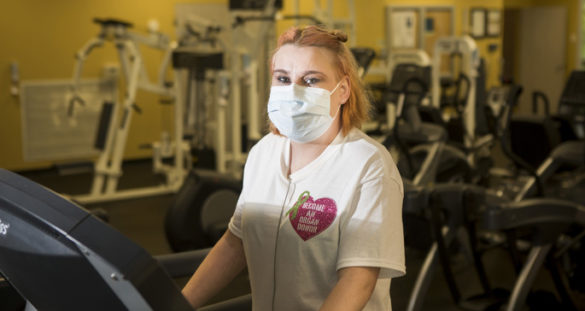
South Carolina resident Amy Binkley is used to making tough decisions for her daughter, Savannah Parks.
Born with a congenital heart defect called hypoplastic left heart syndrome, which affects the normal blood flow through the heart, her daughter required a heart transplant at age 3 months. A decade later, Binkley donated a kidney to her then 11-year-old daughter.
Both transplants were performed at the Monroe Carell Jr Children’s Hospital at Vanderbilt.
Fifteen years and two transplants later, Binkley was again faced with making a lifesaving decision for her ailing child — to remain on the waiting list for a dual heart/kidney transplant or accept organs from a hepatitis C-positive donor.
Traditionally organs infected with hepatitis C, the most common blood-borne infection, would only be offered to patients who also have the disease. If the organ was not suitable for that patient population, it would be discarded. An estimated 3.5 million people in the United States are living with the chronic infection.
At the Vanderbilt Transplant Center, surgeons and physicians had already demonstrated the ability to transplant and manage both liver and hearts from a hepatitis C-positive donor into a non-positive recipient with successful outcomes.
“Because of the incredible advances in medical science, there is an antiviral therapy that cures hepatitis C,” said Ashish Shah, M.D., director of Heart Transplant and Mechanical Circulatory Support at Vanderbilt and chair of the Department of Cardiac Surgery.
“Looking to our liver transplant colleagues, our heart transplantation team was emboldened to try this kind of transplant. After we were successful, the Kidney Transplant program moved forward with good outcomes.
“The center’s combined achievements in our individual programs gave us the green light for a multi-visceral transplant using hepatitis C positive organs in a patient with no evidence of disease,” said Shah.
“It’s how complex care is delivered. Our collective expertise, not available at many centers in the country, saved this patient.”
That decision meant that Binkley’s daughter had another option. One that was imperative for her survival.
“I was on the fence about it when it was first mentioned to me,” said Binkley. “Savannah was getting worse and she needed the transplant. But on the other hand, she had already been through so much. I didn’t want to give her another issue to deal with.
“I think if she had a few weeks or so, we would have considered buying time on the waiting list. But we knew we didn’t have that kind of time. We agreed to a higher-risk donor.”
On July 13, Binkley consented to the increased infectious risk donor. Three days later, she received the news she prayed for: both organs were available for her daughter.
The dual organ transplant using hepatitis C positive organs for a disease-free patient was a first for the transplant team at Vanderbilt University Medical Center (VUMC).
Vanderbilt hopes it is on the road to providing additional options for patients and lessening the amount of time some patients are spending on the waiting list for organs.
“These kinds of transplants are increasing the donor pool and presumably expands access to organs to patients who are willing to take an additional risk,” said David Shaffer, M.D., professor of Surgery and chief of Kidney and Pancreas Transplant.
“With the advent of antiviral drugs, we have seen high success rates in eradicating hepatitis C.”
For Shaffer, the transplant had additional meaning. When he joined VUMC in 2001, Savannah was his first pediatric kidney transplant at Children’s Hospital.
“This has been very humbling for me,” said Shaffer of his involvement in both lifesaving transplantations. “It’s great that her kidney lasted 15 years. It’s especially meaningful to be part of this effort. I’m hopeful that she will have another good result from both organs.”
Binkley’s wishes are the same.
She and her daughter will remain in the Nashville area for few months for rehabilitation services and follow-up appointments.
“All I kept thinking about when I was making this decision was giving my daughter an additional 25 years or more,” said Binkley. “Knowing there was a cure for hepatitis C made it a little easier. Before I agreed to the higher-risk transplant, we were looking at months or even years on the waiting list. We have been at Vanderbilt from the very beginning. I trust them and value their expertise.”
Part of that ease in continued care is thanks to a program developed by Mark Wigger, M.D., assistant professor of Medicine and medical director of the Adult Heart Transplant Program, and Deborah Dodd, M.D., medical director of the Pediatric Heart Transplant Program at Children’s Hospital.
In 2012, the pair and a team of transplant nurses designed the Adolescent-to-Adult Transition Program at Vanderbilt to help a patient population that historically was not surviving into adulthood. Having longstanding relationships with the transplant team can make these decisions somewhat easier because of the trust that has developed over the years, said Wigger.
Savannah was one of the first patients enrolled in the program, he said.
“We were one of the first to develop a program to address the need to empower this patient population as they move into a more independent lifestyle,” said Wigger.
“Less than 40 percent of pediatric programs in the U.S. have transition programs. Congenital heart patients are living longer and the collaborative transition program works to improve long-term survival as well as address a multitude of concerns as they move into adulthood.”
Amy Binkley agrees.
“Savannah is full of life. She has an awesome personality and is pure sunshine,” said Binkley. “She’s a miracle and God is doing something with her. He’s been working on her since she was a baby.”












